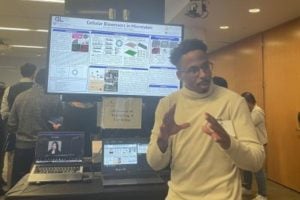
From blood vessels and airways, the human body relies on a network of tiny but important tube-like structures, replicating these complex tubular tissues in the lab has long been a challenge for scientists studying and testing medical treatments. Now a team of Johns Hopkins engineers has described a new way to create microtubes in the lab that accurately mimic those in the human body.
Their work, titled “Cellular Biosensors in Microtubes,” earned the best poster award in the Informatics, AI, Engineering, & Technology Section of the 26th Annual Anesthesiology and Critical Care Medicine Research Day at Johns Hopkins Medicine in December 2024. The team behind the innovative work includes PhD student Chris Acha, chemical and biomolecular engineering Professor David Gracias, and anesthesiology and critical care Professor Lewis H. Romer.
“It was an honor to have this research recognized, and I am excited to see how this new method will impact future research,” said Acha.
To create the models, the team described an approach that mimics how natural tissue forms and folds in the body during human development and a new concept of incorporating sensors within tiny biomimetic tubes. The method involves combining tubular sensors with cellular layers and then using photolithography to pattern wires on self-rolling layers. The self-rolling technique combines inspiration from natural tissues with techniques from the semiconductor chip industry to create precise, layered structures.
“We test the sensors by exposing them to special gels loaded with chemicals like nitrates and dopamine to see how they respond,” said Acha. “Then, using layers of cells that mimic blood vessel walls, we evaluate how well the sensors can measure the function and strength of the cell barriers.”
While researchers have previously created biosensors, they are primarily on flat substrates that fail to capture the curvature effects in real biological tubes. The team says this research represents a move forward in the creation of more realistic tubular in vitro models that could lead to advancements in medical research.
“We hope that this research will open new opportunities for understanding the body’s complex tubular systems,” said Acha.